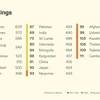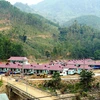A workshop was held in Can Tho city on June 10 to consult southern State agencies and sectors regarding a specific policy to support socio-economic development in ethnic minority communities and mountainous areas and disrupt the high prevalence of poverty.
Despite socio-economic improvements in many minority communities thanks to domestic and foreign resources, an array of difficulties are hindering development efforts such as the mountainous terrain, the shortage of farm land, and the impacts of natural disasters and diseases, said Deputy Minister-Vice Chairman of the Government’s Committee for Ethnic Minority Affairs Son Phuoc Hoan.
The highest rate of household poverty is seen in ethnic minorities, he said, stressing that up to 2,231 communes and over 18,000 hamlets across Vietnam are located in disadvantaged areas where the rate of deprived and near-poor households accounts for more than 45 percent.
The official also blamed the sluggish socio-economic progress on the overlapping and short term Party and State policies along with lax coordination among agencies.
To address those issues, the Committee is working on a specific support policy for the 2016-2020 period with the aim to minimise overlap, mobilise more mid- and long-term resources for development and provide localities with more autonomy in allocating support.
Giving his opinions on the policy, Vice Chairman of the Steering Committee for the Southwest region Nguyen Quoc Viet said it is difficult to reduce the poverty rate by 4-5 percent annually as set in the policy since localities are currently only able to lift 2-3 percent of ethnic families out of poverty every year.
He continued to say that up to 30 percent of ethnic minority households in the Southwest live under the poverty line, compared to the regional average of 7.8 percent. While about 30-40 percent of the families have gained access to clean water, unemployment is common among high school and university graduates.
Duong Dinh Lac from the Bank for Social Policies of Soc Trang province said the policy should focus on both short- and long-term. It is easy to satisfy temporary needs such as housing, electricity, and drinking water, but the question is how to help ethnic communities earn a sustainable living.
At the workshop, some participants said since ethnic minority people do not have saving habits, the policy should encourage communication activities to shift their mindset rather than focusing on offering material supports.
More assistance should be given to the minority groups with the lowest development levels and favourable conditions are necessary to facilitate access to loans from the Banks for Social Policies to prevent ethnics from borrowing from loan sharks, they added.-VNA
Despite socio-economic improvements in many minority communities thanks to domestic and foreign resources, an array of difficulties are hindering development efforts such as the mountainous terrain, the shortage of farm land, and the impacts of natural disasters and diseases, said Deputy Minister-Vice Chairman of the Government’s Committee for Ethnic Minority Affairs Son Phuoc Hoan.
The highest rate of household poverty is seen in ethnic minorities, he said, stressing that up to 2,231 communes and over 18,000 hamlets across Vietnam are located in disadvantaged areas where the rate of deprived and near-poor households accounts for more than 45 percent.
The official also blamed the sluggish socio-economic progress on the overlapping and short term Party and State policies along with lax coordination among agencies.
To address those issues, the Committee is working on a specific support policy for the 2016-2020 period with the aim to minimise overlap, mobilise more mid- and long-term resources for development and provide localities with more autonomy in allocating support.
Giving his opinions on the policy, Vice Chairman of the Steering Committee for the Southwest region Nguyen Quoc Viet said it is difficult to reduce the poverty rate by 4-5 percent annually as set in the policy since localities are currently only able to lift 2-3 percent of ethnic families out of poverty every year.
He continued to say that up to 30 percent of ethnic minority households in the Southwest live under the poverty line, compared to the regional average of 7.8 percent. While about 30-40 percent of the families have gained access to clean water, unemployment is common among high school and university graduates.
Duong Dinh Lac from the Bank for Social Policies of Soc Trang province said the policy should focus on both short- and long-term. It is easy to satisfy temporary needs such as housing, electricity, and drinking water, but the question is how to help ethnic communities earn a sustainable living.
At the workshop, some participants said since ethnic minority people do not have saving habits, the policy should encourage communication activities to shift their mindset rather than focusing on offering material supports.
More assistance should be given to the minority groups with the lowest development levels and favourable conditions are necessary to facilitate access to loans from the Banks for Social Policies to prevent ethnics from borrowing from loan sharks, they added.-VNA



















